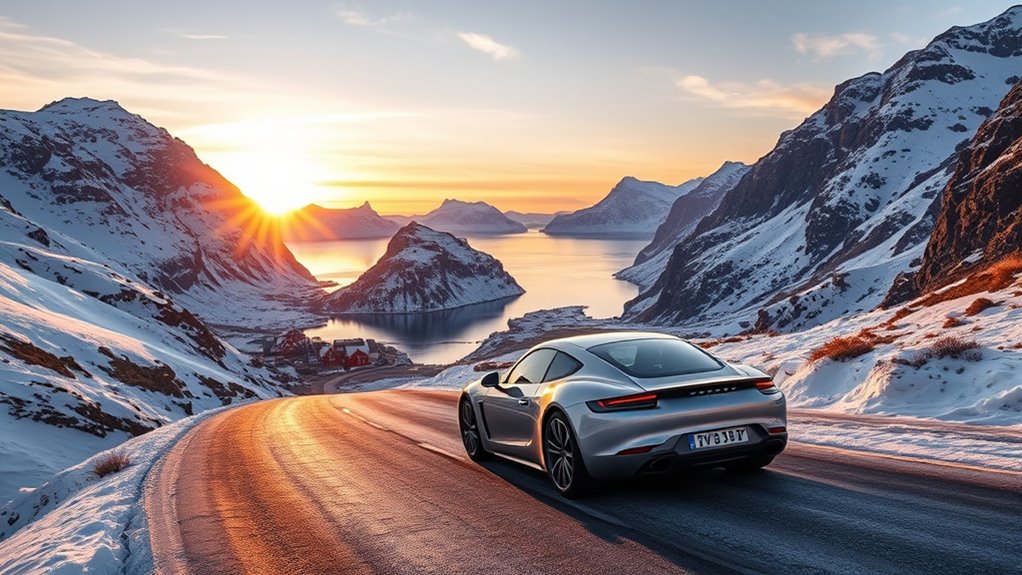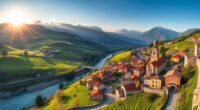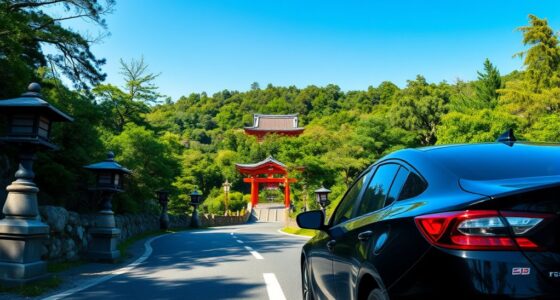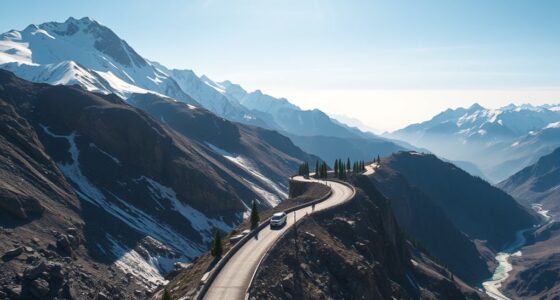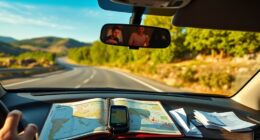Driving Norway’s Arctic Circle to Lofoten offers you stunning landscapes, rugged coastlines, and charming fishing villages. You’ll follow scenic routes like the E6 highway and the Lofoten Coastal Route, passing fjords, mountains, and cultural sites. Prepare for winter risks with proper gear and vehicle checks. Explore natural wonders and learn local traditions along the way. Keep going, and you’ll discover how to make this Arctic adventure unforgettable.
Key Takeaways
- Plan your route along E6 and scenic coastal roads like E10 and Route 866 for breathtaking Arctic and Lofoten landscapes.
- Prepare your vehicle with winter tires, snow chains, and emergency supplies suitable for Arctic conditions.
- Pack layered, waterproof clothing and gear to stay warm and dry in extreme cold and polar night environments.
- Check weather and road conditions regularly to adapt your itinerary and ensure safe travel through remote areas.
- Support local communities by choosing accommodations, eateries, and tours that promote sustainable and cultural experiences.
Preparing for the Arctic Circle Drive

Before setting out on your Arctic Circle drive in Norway, it’s essential to prepare thoroughly. Check your vehicle’s condition, ensuring tires are suitable for winter conditions and fluids are topped off. Pack warm clothing, including layered outfits, hats, gloves, and waterproof gear, since temperatures can drop unexpectedly. Bring navigation tools, like GPS and physical maps, because some areas have limited signal. Stock up on snacks, water, and emergency supplies in case you face delays or rough weather. Familiarize yourself with local driving laws and weather forecasts. Plan your stops and accommodations ahead of time to avoid last-minute stress. Being well-prepared boosts your confidence and safety, allowing you to fully enjoy the stunning Arctic landscapes Norway offers. Navigation tools and proper planning can also improve your overall experience by keeping you on track and safe during your journey. Additionally, understanding vehicle maintenance requirements for winter conditions can prevent breakdowns and ensure a smoother trip. Being aware of road conditions helps you adapt your driving to the changing environment and stay safe throughout your adventure.
Key Routes and Scenic Byways
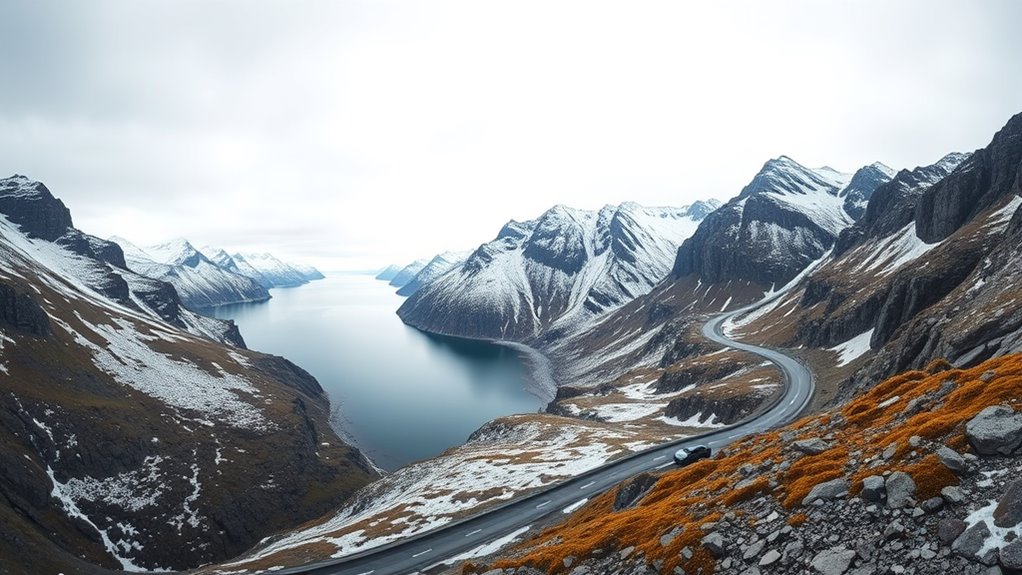
Which routes best showcase Norway’s Arctic beauty? The E6 Highway is your main artery, snaking through stunning fjords, mountains, and vast tundra. It connects Oslo to the north, offering breathtaking views along the way. Near Tromsø, the Arctic Route (route 866) takes you closer to the wilderness, with rugged coastlines and dramatic landscapes. The scenic Lofoten Coastal Route (E10) is a must-see, winding through fishing villages and over mountains with panoramic ocean views. For a truly immersive experience, take the Nordkapp Road to reach North Cape, where vast cliffs meet the Arctic Ocean. These routes highlight Norway’s diverse Arctic scenery, giving you unforgettable vistas at every turn. Combining these scenic byways ensures an adventurous, eye-opening journey through Norway’s Arctic heartland. Highway networks provide essential routes that connect different regions and enhance your exploration. Exploring local scenic routes allows travelers to fully appreciate the natural beauty and rugged charm of the Arctic landscape, especially through scenic byways that reveal hidden gems and breathtaking vistas. Additionally, utilizing sound healing science principles can enrich your journey by incorporating mindful listening experiences amidst the stunning scenery.
Essential Gear and Travel Tips
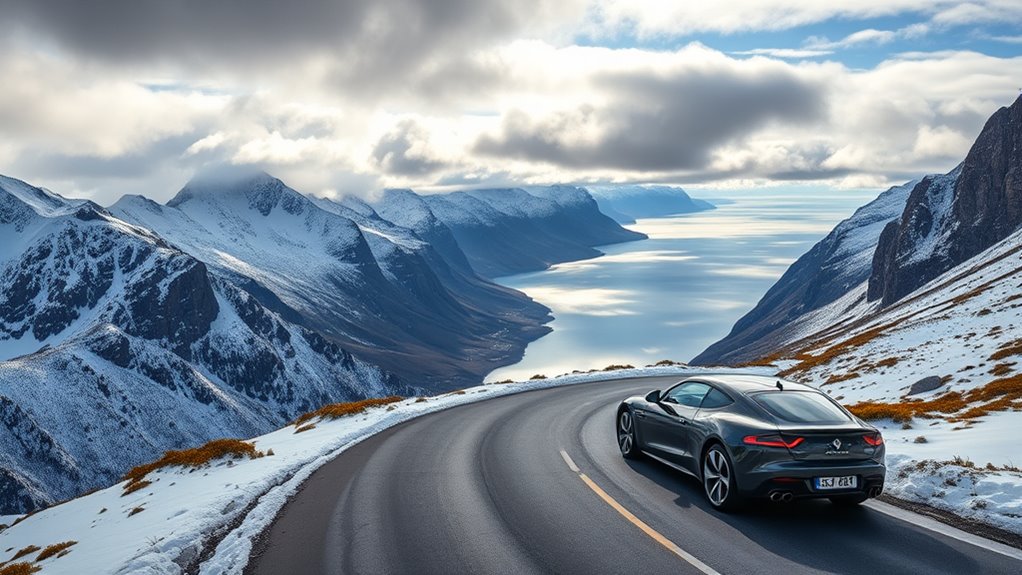
To make your road trip smooth and safe, you’ll want to pack appropriate winter clothing, plan your route carefully, and carry essential safety gear. Being prepared for changing weather and tricky roads will help you enjoy the journey without stress. Let’s explore the must-have gear and tips to keep you comfortable and secure on this Arctic adventure. Additionally, ensuring your vehicle and equipment meet safety standards and regulations is crucial for a worry-free trip, especially in such harsh environments like proper vehicle maintenance and safety compliance. Incorporating remote work productivity strategies can help you stay connected and manage any work commitments efficiently during your travels. Staying informed about emerging AI security challenges can also help you understand potential risks and how to mitigate them, ensuring your safety and peace of mind in unpredictable conditions. Using reliable paint sprayer accessories can also prevent unexpected issues during vehicle upkeep, ensuring all your equipment functions properly in demanding conditions.
Winter Clothing Essentials
When traveling through Norway’s Arctic Circle to Lofoten in winter, layering is your best defense against the cold. Start with a moisture-wicking base layer to keep sweat away from your skin. Add an insulating layer, like a fleece or down jacket, to trap heat. Top it with a waterproof, windproof shell to shield you from snow and icy winds. Don’t forget warm accessories: a hat that covers your ears, insulated gloves, and a scarf or neck gaiter. Sturdy, waterproof boots with good traction are essential for walking on snow and ice. Pack extra socks and thermal underwear for added warmth. Always check the weather forecast and be prepared to adjust layers accordingly. This layered approach keeps you warm, dry, and comfortable during your winter adventure. Ensuring proper layering techniques can make a significant difference in maintaining body heat in harsh winter conditions, especially when considering the importance of thermal insulation in extreme cold environments. Incorporating active listening skills can also enhance your experience by helping you stay attuned to changing weather conditions and your own comfort levels. Additionally, understanding the layering strategies for extreme cold can help optimize your gear choices for maximum warmth and safety.
Road Trip Planning Tips
Planning a smooth road trip through Norway’s Arctic Circle to Lofoten requires packing the right gear and preparing for variable conditions. Guarantee you have versatile clothing layers, a reliable GPS, and a portable charger. Prepare for changing weather with waterproof gear, warm blankets, and extra food and water. Consider your vehicle’s necessities, like a spare tire and emergency kit. To help organize, here’s a quick checklist:
| Essential Gear | Travel Tips |
|---|---|
| Warm clothing layers | Check road conditions regularly |
| Waterproof gear | Allow extra travel time |
| Navigation tools | Share your itinerary with someone |
| Emergency supplies | Keep a first aid kit handy |
Additionally, incorporating safety precautions into your planning ensures a secure journey through remote areas. It’s also beneficial to familiarize yourself with local weather patterns to better anticipate and adapt to unexpected conditions. Recognizing the importance of proper gear selection can significantly improve your overall experience and safety during the trip.
Safety and Navigation Gear
Ensuring you have the right safety and navigation gear can make all the difference on your Arctic Circle journey to Lofoten. Proper gear keeps you safe, helps you stay on course, and handles unexpected weather. First, a reliable GPS device or smartphone with offline maps guarantees you won’t get lost in remote areas. Second, pack a sturdy, high-visibility vest and a flashlight—crucial for roadside emergencies or low-light conditions. Third, carry a thorough emergency kit with warm clothing, first aid supplies, and extra food and water. Additionally, consider snow chains for tires and a portable charger. Staying prepared with these essentials guarantees you can navigate safely, respond to emergencies swiftly, and enjoy your adventure with confidence. Incorporating navigation tools can further enhance your ability to stay on track in challenging environments, especially in areas where remote locations make assistance hard to access. Moreover, understanding juice cleansing techniques can be beneficial if you plan to maintain your energy and hydration levels during long trips in the Arctic.
Cultural Highlights Along the Way
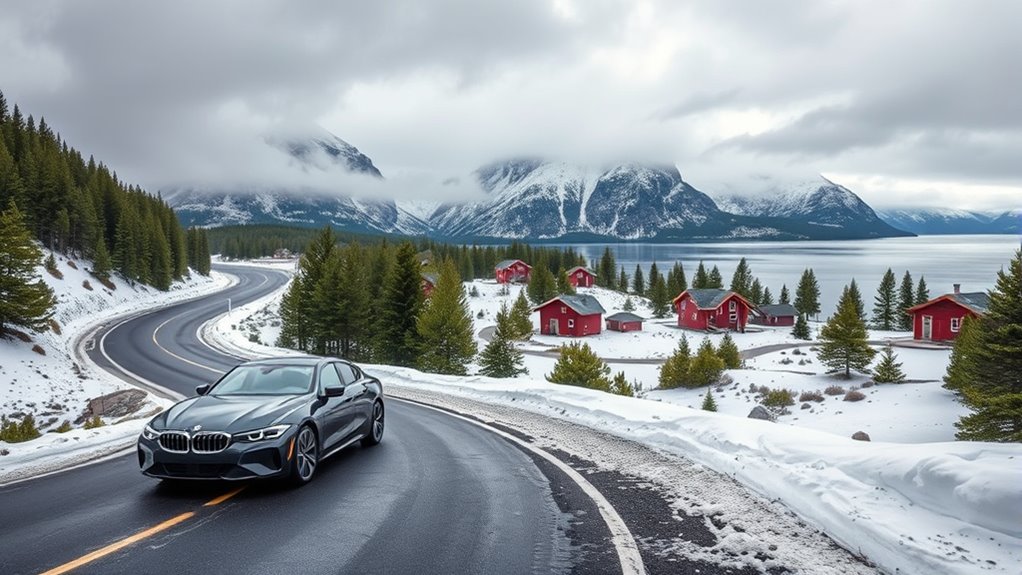
As you drive through Norway’s Arctic landscape, you’ll encounter a rich tapestry of cultural highlights that offer a glimpse into the region’s unique heritage. You might stop at traditional fishing villages where colorful wooden houses line the shores, revealing Norway’s seafaring history. In small towns, look for Sami cultural centers showcasing indigenous crafts, music, and reindeer herding traditions. Along the way, you’ll find museums that detail Viking history and local folklore, giving you insight into Norway’s ancient roots. Local festivals often celebrate traditional foods, music, and dances, allowing you to immerse yourself in the vibrant community life. These cultural touches enrich your journey, connecting you deeply with Norway’s Arctic identity beyond its stunning scenery.
Natural Wonders and Geological Features

Moving through Norway’s Arctic landscape reveals a stunning array of natural wonders and striking geological features. You’ll encounter towering fjords carved by glaciers, their sheer cliffs dropping into icy waters. The landscape is dotted with massive granite formations, like the iconic Preikestolen cliff, offering breathtaking views. Don’t miss the following geological marvels:
- Fjords—deep, glacially carved inlets that define Norway’s coast.
- Glacial Valleys—U-shaped valleys shaped by ancient ice flows.
- Unique Rock Formations—such as the Lofoten Islands’ dramatic peaks and beaches. These features showcase millions of years of geological activity, creating a dramatic, raw landscape that’s both awe-inspiring and uniquely Norwegian. Geological processes have played a fundamental role in shaping this remarkable terrain, highlighting the importance of tectonic activity in forming Norway’s rugged scenery. Additionally, erosion continues to sculpt the landscape, revealing new formations over time.
Best Times to Experience the Midnight Sun and Northern Lights

The best time to see the midnight sun is during the summer solstice, when daylight lasts all day long. If you prefer the northern lights, plan your trip around winter’s polar night for the clearest skies. Shoulder seasons also offer unique chances to experience these natural wonders without the crowds. Additionally, understanding the leadership skills involved in planning such trips can enhance your travel experience by ensuring well-organized and memorable adventures. Being aware of seasonal weather patterns can help you prepare appropriately for the varying conditions in Norway’s Arctic regions. Incorporating grocery savings strategies into your travel planning can help you manage expenses more effectively during extended trips, allowing for a more enjoyable experience. Proper gear selection, such as appropriate clothing and equipment, is also crucial for comfort and safety during these extreme conditions.
Summer Solstice Peak
Ever wondered when you can experience Norway’s midnight sun and the Northern Lights at their most spectacular? The summer solstice, around June 21st, is the peak time. During this period, the midnight sun shines continuously above the Arctic Circle, offering endless daylight. To make the most of this time, consider these key points:
- The midnight sun lasts from late May to late July, with the peak on the solstice.
- Clear, long nights of summer are perfect for spotting the Northern Lights before they fade.
- The extended daylight hours give you more time for outdoor adventures, from hiking to sightseeing.
- Understanding the home essentials and preparing accordingly can enhance your experience in such extreme natural conditions.
This unique combination makes summer the best season to witness Norway’s extraordinary natural phenomena. Plan your trip around this period to maximize your experience.
Winter Polar Night
As summer’s endless daylight fades, Norway shifts into its winter polar night, a period when the sun stays below the horizon for weeks on end. During this time, the Arctic darkness creates a unique, serene atmosphere perfect for experiencing the Northern Lights. You’ll find long nights with minimal daylight, making it easier to spot the aurora borealis dancing across the sky. The cold air sharpens the colors, creating a vivid, almost surreal spectacle. This period is ideal for cozying up under blankets in remote lodges or venturing outside with warm gear to witness the silent, star-filled night. Embrace the stillness and let the winter darkness deepen your connection with Norway’s Arctic wilderness. The polar night offers an unforgettable, mystical experience.
Shoulder Season Wonders
Shoulder seasons in Norway offer a compelling window to experience both the midnight sun and the Northern Lights, often with fewer crowds and more flexible weather conditions. During these times, you can enjoy the surreal glow of the midnight sun or catch the auroras without the peak season hustle. To make the most of this period, consider these key moments:
- Late April to early May – daylight extends, and chances to see the Northern Lights still exist.
- September to early October – the midnight sun fades, but the Northern Lights become more visible.
- Transition months – enjoy milder weather, fewer tourists, and unique landscapes as seasons shift.
These shoulder seasons let you experience Norway’s natural wonders with a more relaxed, intimate atmosphere.
Top Activities and Outdoor Adventures
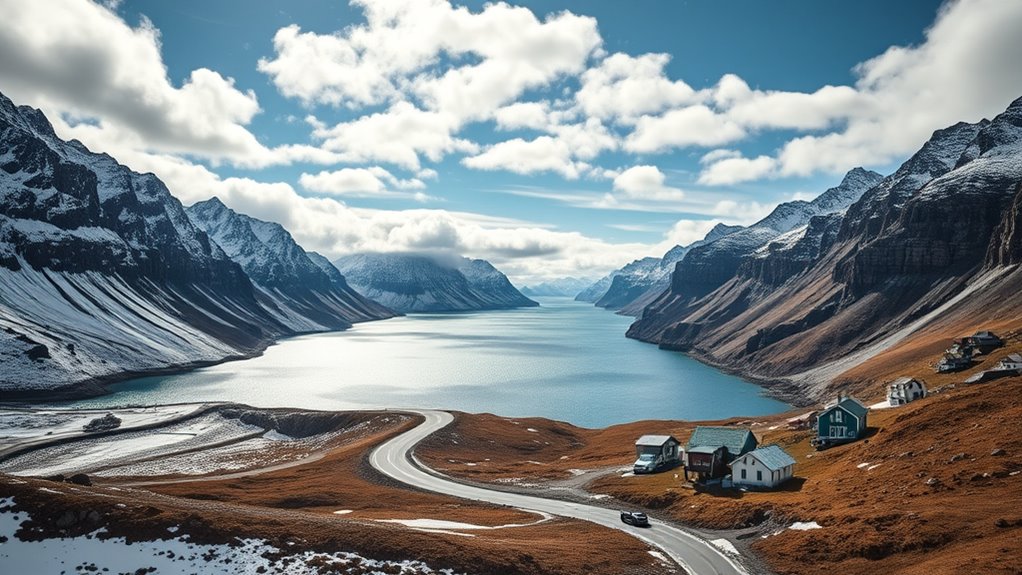
Driving through Norway’s Arctic Circle to Lofoten offers a wealth of thrilling outdoor activities. You can hike dramatic mountain trails with breathtaking fjord views or explore pristine beaches where the midnight sun casts a golden glow. Kayaking in crystal-clear waters puts you close to rugged coastlines and abundant wildlife, including sea eagles and seals. For adrenaline junkies, mountain biking across rugged terrains challenges your skills while providing panoramic scenery. You might also try fishing in icy waters or setting out on a wildlife safari to spot reindeer and seabirds. During winter, snowshoeing and cross-country skiing open up pristine snowy landscapes, offering peaceful escapes. No matter your interest, Norway’s Arctic region promises unforgettable outdoor adventures that connect you deeply with its stunning natural beauty.
Navigating Local Villages and Fishing Ports
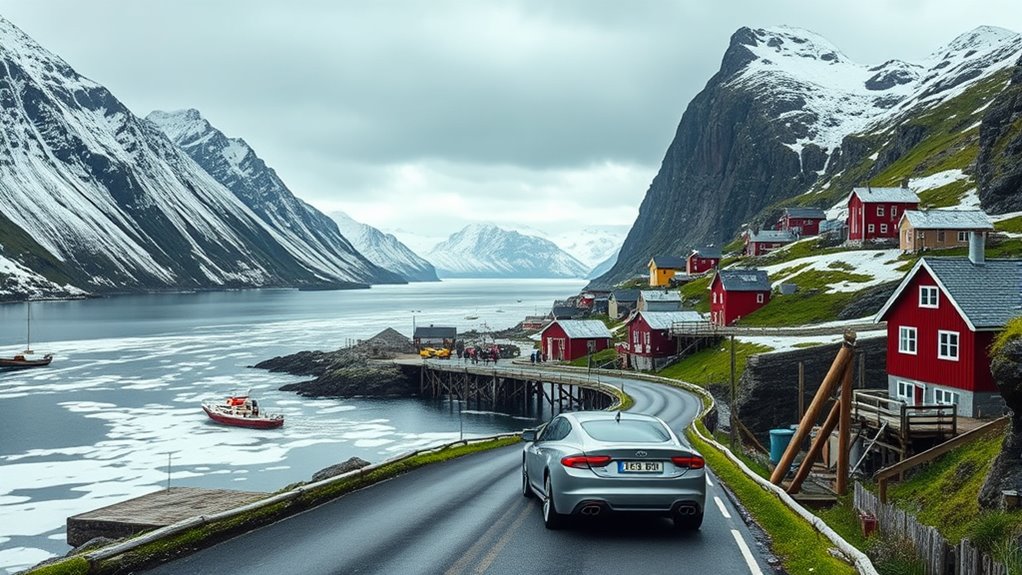
Exploring Norway’s coastal villages and bustling fishing ports gives you a firsthand look at local life and maritime traditions. As you navigate these lively spots, you’ll notice three key aspects:
- The vibrant activity of fishermen unloading freshly caught fish.
- Small boats bobbing in the harbor, ready for the next trip.
- Local markets offering smoked salmon, cod, and other seafood delicacies.
You’ll feel the authentic atmosphere as locals chat at dockside cafes or mend nets on the quay. Driving through narrow streets lined with colorful houses, you get a sense of community and history. Watch for signs pointing to traditional fishermen’s cabins and small art galleries showcasing local craftsmanship. These villages offer a genuine glimpse into Norway’s maritime soul.
Sustainable Travel Practices in Arctic Norway
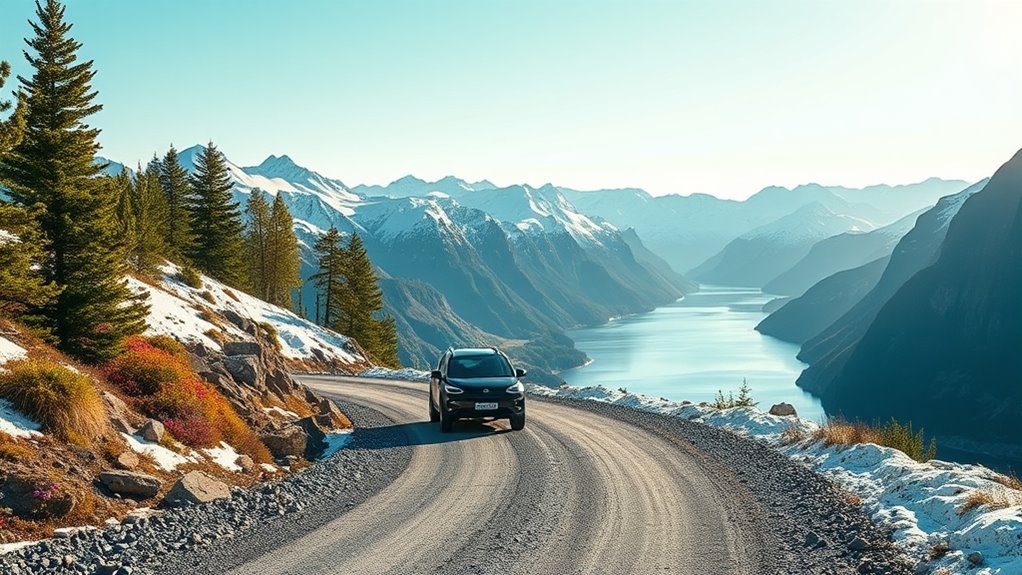
As you explore Arctic Norway, consider using eco-friendly transportation options like electric cars or local ferries to reduce your carbon footprint. Respect the natural environment by staying on designated trails and avoiding disturbance to wildlife. Supporting local communities through responsible travel helps preserve the culture and resources that make this region unique.
Eco-Friendly Transportation Options
To reduce your environmental impact while journeying through Arctic Norway, consider adopting eco-friendly transportation options. First, opt for electric vehicles or hybrids, which produce fewer emissions and are increasingly available for rentals. Second, use local public transportation like buses or trains, which lower the carbon footprint compared to driving alone. Third, explore biking or walking for short distances, allowing you to enjoy nature while minimizing your footprint. Car-sharing programs are also a smart choice, reducing the number of vehicles on the road. By choosing these options, you contribute to preserving Norway’s pristine landscapes and reduce pollution. Eco-friendly transportation not only benefits the environment but also enhances your travel experience with more authentic and intimate encounters with Arctic Norway’s stunning scenery.
Respecting Natural Environments
Choosing eco-friendly transportation options already helps reduce your environmental impact, but respecting the natural environments you encounter is equally important. When exploring Arctic Norway, stick to designated trails and avoid disturbing wildlife or fragile landscapes. Keep noise levels low to prevent startling animals and disrupting their habitats. Always dispose of waste properly, packing out everything you bring in, including trash and food scraps. Respect local flora by refraining from picking plants or trampling delicate mosses and lichens. Stay on marked paths to prevent erosion, and avoid building fires in wild areas. By practicing these habits, you help preserve Norway’s stunning Arctic environment for future visitors and ensure your trip leaves a positive impact on the land.
Supporting Local Communities
Supporting local communities while exploring Arctic Norway guarantees your travels benefit the region and its people. To make a positive impact, consider these steps:
- Choose locally owned accommodations and eateries to support small businesses.
- Participate in community-led tours that promote traditional knowledge and culture.
- Buy handmade crafts and local produce directly from artisans and farmers.
Planning Your Lofoten Islands Exploration

Planning your Lofoten Islands exploration requires careful consideration of the best time to visit, transportation options, and key sights you want to experience. Decide whether you want to chase the midnight sun in summer or see the Northern Lights in winter, as each season offers unique experiences. Consider renting a car to explore remote villages and scenic landscapes at your own pace. Alternatively, buses and ferries connect major spots, but they may limit flexibility. Prioritize must-see destinations like Reine, Hamnøy, and Å, and plan outdoor activities such as hiking, kayaking, or fishing. Booking accommodations early guarantees better choices, especially during peak seasons. With thoughtful planning, you’ll maximize your time and create a memorable adventure in this stunning Arctic paradise.
Frequently Asked Questions
What Customs and Immigration Procedures Are Required When Entering Norway’s Arctic Region?
When entering Norway’s Arctic region, you’ll need to go through customs and immigration. You should carry a valid passport or ID, and if you’re from outside the Schengen Area, you might undergo passport checks. Customs officers may inspect your luggage for prohibited items. Make sure to declare any goods over the allowed limit. Overall, the process is straightforward, but having your documents ready speeds things up.
Are There Specific Driving Licenses Accepted for Arctic Circle Road Trips in Norway?
Imagine you’re planning a road trip through Norway’s Arctic region. You should know that a standard European driving license usually suffices, but if you’re from outside Europe, you might need an International Driving Permit (IDP). For example, a traveler from the US would carry both their driver’s license and IDP. Always check current regulations, as requirements can change, ensuring you stay legal and safe on your adventure.
How Do Weather Conditions Impact Road Accessibility During Different Seasons?
Weather conditions considerably impact road accessibility throughout the year. In winter, snow and ice can make roads slippery and sometimes close routes entirely, so you need to check updates frequently. During spring and autumn, rain and fog reduce visibility and cause potential landslides or flooding. Summer generally offers better driving conditions, but occasional storms can still disrupt travel plans. Always stay informed about weather forecasts and road status before heading out.
What Local Safety Regulations Should Travelers Be Aware of in Remote Arctic Areas?
In remote arctic areas, you should be aware of local safety regulations, like mandatory vehicle equipment for winter driving, such as snow tires and chains. Always heed posted speed limits, especially in icy or snowy conditions, and respect wildlife and environmental protection rules. Check local advisories before traveling, and carry emergency supplies. Following these regulations helps guarantee your safety and preserves the pristine environment you’re exploring.
Are There Recommended Insurance Policies for Driving in Norway’S Arctic Region?
They say, “Better safe than sorry,” and that’s especially true when driving in Norway’s Arctic region. You should get extensive insurance, including coverage for roadside assistance and potential weather-related issues. Check if your policy covers winter conditions, gravel roads, and emergencies. It’s wise to compare policies from different providers and consider add-ons like trip interruption or gear protection, ensuring you’re fully prepared for the unpredictable Arctic terrain.
Conclusion
Setting out on Norway’s Arctic Circle to Lofoten offers a breathtaking adventure you won’t forget. Did you know that the Northern Lights can be seen up to 200 nights a year in this region? By embracing sustainable travel practices, you help preserve these stunning natural wonders for future explorers. So, pack smart, stay curious, and enjoy every moment of this extraordinary journey through one of the world’s most awe-inspiring landscapes.
